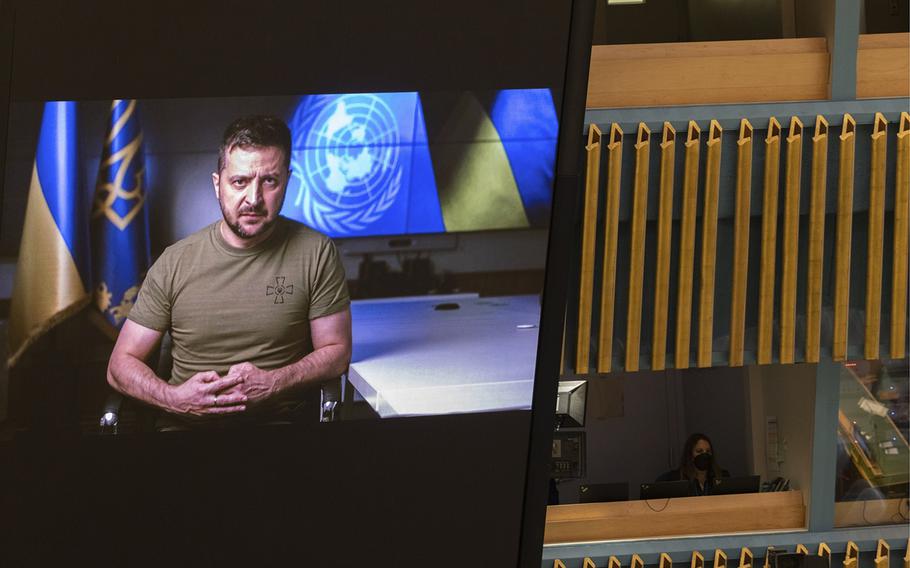
Volodymyr Zelensky, Ukraine’s president, on a monitor during the United Nations General Assembly (UNGA) in New York on Sept. 21, 2022. (Jeenah Moon/Bloomberg)
President Volodymyr Zelenskyy of Ukraine is ending 2022 in a strong and highly visible manner. On Dec. 21, he addressed both houses of the U.S. Congress and received multiple standing ovations. Time magazine has named him Person of the Year.
The war in Ukraine continues, with devastating, perhaps irreparable damage to the influence and image of President Vladimir Putin of Russia, and also the military of his nation. Rightly, the Red Army of the Soviet Union was generally respected, and greatly feared by those nations occupied by that powerful force.
After all, this was the military organization that faced, fought and ultimately destroyed the bulk of the enormous war machine of Nazi Germany. The vast majority of the mechanized units of the Wehrmacht were deployed on the Eastern Front, a theater where the war was literally a fight to the collective death, without the restraints present in combat involving American, British and others in the West.
During the Cold War, the Soviet Army with some regularity suppressed popular revolts in occupied nations with relative ease. These included East Germany in 1953, Hungary and Poland in 1956, and Czechoslovakia in 1968. Yugoslavia successfully broke away in 1948.
Clearly, Putin and associates miscalculated how easily Russia’s military would be able to occupy Ukraine and take control, in Cold War fashion. As in armed conflict through history, determination and courage of the people of Ukraine has been the vital factor.
But Russian forces have also proven extraordinarily deficient. Mechanized weapons and equipment have broken down to a striking degree, military units are ineffective and general disorganization has accompanied the large but clumsy invasion. Clear by now is that the end of the Soviet Union also has opened the door to corruption and disorganization, undeniably and extraordinarily widespread.
In a particularly shocking development, dead Russian soldiers have simply been left where they lie on the battlefield by retreating comrades. Not abandoning comrades, alive or dead, is a traditional tenet of military culture.
One key factor almost never mentioned is Putin’s own lack of military experience, including combat, in contrast to leaders of the Soviet Union. He was in the KGB, technically a military organization, but in reality, an intelligence arm of the Soviet Communist Party.
The Biden administration decision to provide the Patriot missile defense system to Ukraine is important. The Patriot is part of a great revolution in military technologies over the 19th and 20th centuries.
In World War II, various changes created a much more fluid battle environment. The tank and other motorized vehicles, long-range heavily armed aircraft, modern electronic communications and other innovations drastically altered the characteristics of fighting.
One important innovation was the Tube-launched Optically tracked Wire-guided missile, or TOW, a relatively small lethal anti-tank weapon. The German V-1 rocket of World War II was a very early example of a guidance system within a missile. Related technologies have evolved to an extraordinary degree since that time.
In the spring of 1972, North Vietnam launched a massive armored invasion of South Vietnam. TOW missiles, usually launched from helicopters, completely devastated large numbers of Soviet-supplied tanks along with other targets. This offensive was destroyed.
Other Precision-Guided Munitions (PGMs) include the Stinger anti-aircraft missile. This weapon proved important in defeating the Soviet invasion of Afghanistan, over a decade starting in 1979.
From 1973, the Pentagon began to develop a satellite network for use in earth navigation. The resulting Global Positioning System alleviated the challenge, as old as warfare, of determining accurately the location of forces.
Technologies equalize numerical disparities. However, the human element remains key.
Ukraine demonstrates strength in both dimensions.
Arthur I. Cyr is author of “After the Cold War — American Foreign Policy, Europe and Asia.”